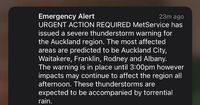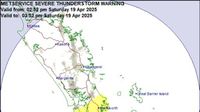Auckland residents are grappling with the aftermath of severe thunderstorms that struck the city on April 19, 2025, leaving a trail of destruction and prompting emergency alerts from MetService. The storm, which was fueled by the remnants of ex-Cyclone Tam, led to widespread flooding, power outages, and significant disruptions to travel.
MetService issued two emergency alerts within a short span, warning Aucklanders of the impending thunderstorms that were expected to be accompanied by torrential rain. The alerts, sent just after 2 PM, covered Auckland City, Waitakere, Franklin, Rodney, and Albany, and were lifted around 3 PM. However, Auckland Emergency Management advised residents to remain cautious until 6 PM, as conditions were expected to remain volatile.
Adam Maggs, general manager of Auckland Emergency Management, highlighted the intensity of the storm, stating, "It has been a particularly intense few days weather-wise for our region and that’s expected to continue throughout the afternoon." He urged residents to stay informed about weather updates and to prepare for rapid changes.
The storm kept many Aucklanders awake overnight on April 18, with sheet lightning and rolling thunder disrupting sleep. By the morning of April 19, numerous residents and business owners reported damage from flooding and high winds. Some areas experienced rainfall exceeding 110mm, leading to localized flooding across the city.
As the storm raged, Auckland Airport reported significant disruptions, with seven flights diverted for safety reasons due to the severe weather. Passengers on diverted flights faced long delays, with some stranded on the tarmac at Hamilton Airport for hours. Tensions escalated as passengers became frustrated with the lack of communication and clarity regarding their situation.
One passenger described the ordeal, saying, "We’d circled Auckland a few times, then they told us we didn’t have enough fuel and had to go to Hamilton." Another passenger on a Solomon Airlines flight echoed similar frustrations, stating, "We’ve had a meal on the way here, but since arriving in Hamilton, we’ve only been given one glass of water."
Residents of Mt Albert, including Benjamin Chevre, owner of the Little French Cafe, dealt with the immediate impacts of the storm, receiving a call at 1 AM about flooding in his premises. Chevre reported that his cafe was inundated with up to 25cm of water, marking the third flooding incident since the last severe weather event during Cyclone Gabrielle. He expressed hope that his business could reopen soon, provided the infrastructure remained intact.
Another resident, Syed Shaji from Mt Roskill, described waking up to find water rising above his knees. He expressed concern for his neighbors and took it upon himself to clear debris to prevent further flooding. "Definitely worried to see flooding again... We were worried about our neighbours," he said.
As the storm subsided, Auckland Emergency Management reported that 27 individuals were displaced due to the flooding and were provided shelter at the Fickling Convention Centre in Three Kings. The centre closed at 6 PM, transitioning those unable to return home into emergency accommodation.
Despite the significant challenges posed by the storm, some Aucklanders viewed the wild weather with a sense of awe. One man remarked that he thought the storm was "pretty cool" as he attempted to capture a selfie with the lightning flashing in the background. However, for many others, the storm brought back memories of past disasters, including the devastating Auckland Anniversary weekend floods of 2023.
Social media was abuzz with reactions to the storm, with many residents expressing frustration over the timing of the alerts. Critics pointed out that the severe weather conditions had unfolded rapidly, leading to a lack of timely warnings. Auckland City Councillor Shane Henderson voiced concerns about the delayed notifications, stating, "I do think a warning should have been put in place a bit earlier than midnight."
MetService meteorologist Alec Holden acknowledged the difficulties in forecasting such storms, noting that thunderstorms can develop quickly and unpredictably. He explained, "These types of events can happen very quickly and without warning," emphasizing the challenge of predicting their severity.
In response to the storm, Auckland Emergency Management activated its emergency coordination center, working closely with Fire and Emergency New Zealand to address the numerous calls for assistance. During the storm, firefighters responded to 223 weather-related calls, including two water rescues where individuals were trapped in their vehicles.
As Aucklanders begin to recover from this latest weather event, the focus now shifts to assessing the damage and ensuring that effective communication and preparedness measures are in place for future storms. The lessons learned from this incident will be crucial for enhancing the city’s resilience against severe weather.
In the wake of the storm, Auckland Mayor Wayne Brown acknowledged the discomfort many residents experienced during the night, thanking the emergency management team for their rapid response. He stated, "The team followed all the emergency protocols and mobilised quickly to respond to what was an unpredictable set of circumstances with an intense thunderstorm band that quickly developed into a sustained period of heavy rain."
As Auckland continues to brace for potential wild weather in the coming days, residents are reminded to stay vigilant, keep informed about weather updates, and prepare for any unexpected changes.






